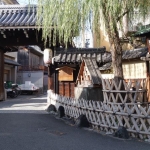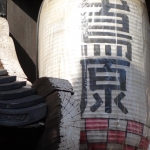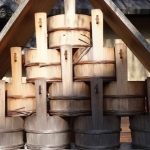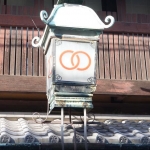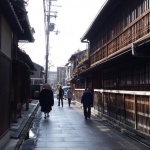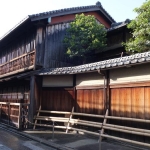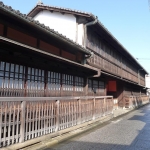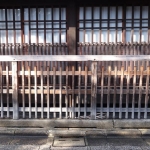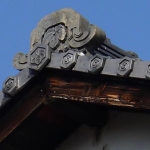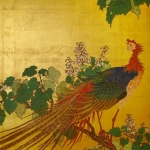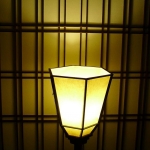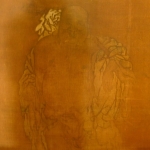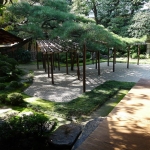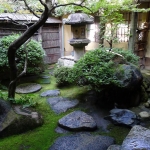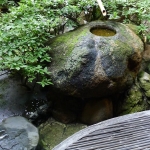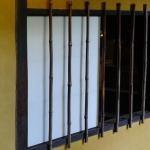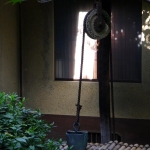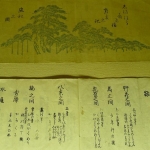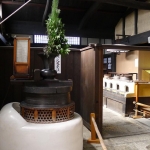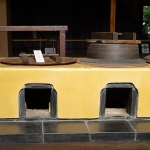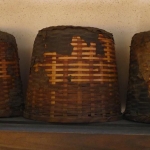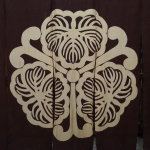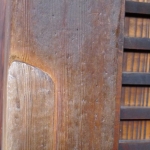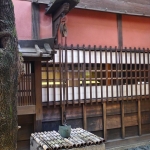Sumiya and the Shimabara District
If I were only sure
I could live as long as I wanted to,
I would not have to weep
at parting from you.
–Shirome
Red: Places of Interest Blue: Eat Green: Sleep
Although the Shimabara (Western Pleasure Quarter) as opposed to the Gion (Eastern Pleasure Quarter) is no longer a pleasure quarter, one goes there to walk this old district and visit the historic Sumiya.
I arrived by taxi at the O-mon gateway to Shimabara and wandered the early morning streets, making an offering to a wandering monk, before meeting with Masako-san who would accompany me to Sumiya and be my translator.
Located in a former pleasure district known as Shimabara, in central Kyoto, Sumiya is now a museum open to the public, and is the last surviving example of ageya architecture. Being able to see this ageya as it was in the Edo period is a real rarity in Japan. Okiya were residences where the entertainers awaited a summons to the ageya.
Ageya were elegant restaurants where Geisha or Geiko and Tayu (primiere Geiko) performed. Performances included elaborate tea ceremonies, songs and dances.
Sumiya has been owned and managed by the Nakagawa family since 1641 and the present enlarged buildings date from 1787. In 1952 the building was designated as an Important Cultural Property.
Sumiya is a two story structure with a tiled roof and combines elements of shoin-tsukuri and sukiya-tsukuri styles. The former is the elegant, formal style of the samurai warrior class distinguished by large tatami rooms, painted screens and fine carvings, whereas the latter is the more informal, sparse style of the tea ceremony.
Sumiya was not just a place of entertainment based on “wine, women and song” but also an important salon where famous people in the fields of politics, art and literature gathered, including a group of haiku poets known as Shimabara Haiden and the anti-Tokugawa reformers Saigo Takamori, Kusaka Genzui and Sakamoto Ryoma, who met here with rich merchants to try and secure funds for their struggle. Their opponents, the pro-Tokugawa Shinsengumi, also met here in the final years of the Tokugawa regime.
Visitors enter through the original kitchen area and then remove their shoes as they enter the exhibition rooms. The kitchens preserve their original clay ranges with wooden lids and a variety of cooking implements of the period are on display.
The exhibition rooms have glass cases displaying some beautiful ceramics including dishes and saké flasks, Edo period documents relating to the administration and business operations of the restaurant and some exquisite lacquerware. Other tatami rooms hold priceless byobu folding screens and fusuma-e (paintings on sliding doors).
Works by some of the greatest artists of the Edo Period (1603-1867) can be seen in Sumiya including “Plum Blossoms” a National Treasure by Yosa Buson (1716-1784) as well as works by Kishi Ganku (1756-1836), Maruyama Okyo (1733-1795), Emura Shumpo and Yamada Gazan.
Another item of particular interest is a wooden sword rack, where patrons were to leave their swords.
The highlight of a visit to Sumiya for many visitors is its exquisite garden viewed from an engawa (narrow veranda) running around the edge of the rooms facing it. The raked gravel garden contains a spreading pine tree and a late-flowering cherry.
Wachigai-ya
Wachigai-ya is another preserved geisha teahouse or okiya dating from the 1680s. In its heyday, Wachigai-ya was frequented by trainee geisha and tayu and the latticed wooden building displays a gaslight with the linked circle crest of the the tea house.
It is not open to the public and invitation is required This is a venue where entertainers still meet customers. Tourists are not welcome and opening hours are not posted.
Another place of interest in Shimabara is a small shrine on the way to JR Tambaguchi Station, called Shimabara Sumiyoshi Jinja, which was the tutelary shrine of the one-time entertainment district.
If you wish to stay and sample the atmosphere of this peaceful and historic area, the Shoei Ryokan boasts an outdoor bath (rotemburo) made from lava from Mt. Fuji and traditional Japanese cuisine
If you choose to stay in this area: http://www.yunoyadosyouei.jp/ryokan-kyoto/
After, you might enjoy exploring the Nishi-Honganji and Higashi-Honganji temple areas.
In the spring of 2000, I had the opportunity to observe the Tayu Dochu at Josho-ji Temple.
Josho-ji Temple was founded by a Nichiren Sect priest Nichiken Shonin in 1616 on an estate contributed to the temple by Hon’ami Koetsu. In 1627, the temple opened a school with a dormitory for Buddhist priests to learn, enrolling over 300 Renshu priests in the peak period.
The temple is also known for its connection with a famous courtesan Yoshino Tayu. Yoshino Tayu was well known as the top-ranking courtesan in Shimabara, not only for her beauty but also for her knowledge and talent in waka (poetry), kado (flower arrangement), taiko (drum), shamisen (three-stringed instrument).
She fell in love with a nephew of Hon’ami Koetsu, a wealthy merchant in Kyoto, Haiya Joeki and eloped with him. Later she passed away at the age of 38 and was buried in Josho-ji Temple. During her lifetime, she was a pious believer in the Nichiren Sect teachings and expended her own funds to build a san-mon (temple gate).
On the 2nd Sunday of April each year, a memorial flower festival is held to reminisce about Yoshino Tayu. “Tayu Dochu” is a parade of an active Tayu in her gorgeous kimono with an open-air tea ceremony.
https://en.wikipedia.org/wiki/Oiran
http://www.issendai.com/japanese-courtesans/about-oiran-tayu-names.html


